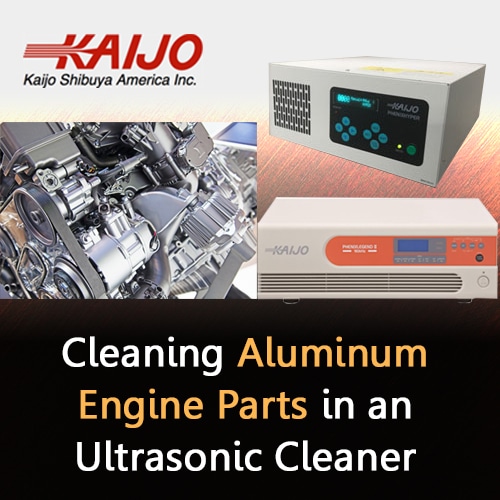Cleaning Aluminum Engine Parts in an Ultrasonic Cleaner
June 23, 2020
 Aluminum engine parts may require routine cleaning or the removal of contaminants prior to re-building. Because aluminum is softer than steel, scrubbing or scraping to remove tough deposits can damage the aluminum surface. Soaking in strong solvents may soften deposits and remove some contaminants but manual or mechanical cleaning is usually required to clean residues.
Aluminum engine parts may require routine cleaning or the removal of contaminants prior to re-building. Because aluminum is softer than steel, scrubbing or scraping to remove tough deposits can damage the aluminum surface. Soaking in strong solvents may soften deposits and remove some contaminants but manual or mechanical cleaning is usually required to clean residues.
Ultrasonic cleaning works more quickly than traditional cleaning methods and delivers superior results. Part surfaces are completely clean, even in difficult to reach places. Soaking with harsh chemicals is eliminated and no manual removal of remaining residues is required. Part surfaces are left undamaged as long as the correct ultrasonic frequency is used. The superior performance of ultrasonic parts cleaners compared to traditional cleaning methods reduces costs and results in cleaner aluminum parts.
Ultrasonic Cleaners Clean Aluminum Engine Parts Completely and Safely
Two of the major advantages of using ultrasonic cleaners are complete one-step cleaning and a safer working environment. Ultrasonic systems rely on the generation of microscopic cavitation bubbles in the cleaning solution. As the ultrasonic sound waves pass through the liquid, these bubbles form and collapse, producing tiny high-energy jets. The jets strike the surface of the aluminum and dislodge deposits and films.
Because the cleaning action of the ultrasonic system doesn’t rely on chemicals, workers don’t need special safety equipment. They can place the parts to be cleaned in the cleaning tank and let the ultrasonic system work without supervision. The cavitation bubbles penetrate wherever cleaning solution is present and clean even inside dead end holes, inside threads, in nozzles and around complex shapes. Cleaning is complete on all surfaces and subsequent manual cleaning to remove any residues is not required. The handling of harsh chemicals and toxic solvents is eliminated and the cleaning process becomes much more environmentally friendly.
Choosing the Correct Ultrasonic Frequency is Critical for Proper Cleaning
Engine parts made from aluminum use different alloys, coatings and metal treatments depending on the characteristics needed for the part. The resulting metal surfaces vary in hardness and can be damaged by cleaning action that is too powerful. Ultrasonic cleaning avoids surface damage from chemicals and from scrubbing or scraping used in traditional cleaning methods but choosing the wrong frequency can lead to surface pitting.
The size of the cavitation bubbles generated by the ultrasonic system depends on the system frequency. Low frequencies generate large bubbles and jets with enough energy to damage soft surfaces. Higher frequencies generate smaller bubbles with less jet energy. The lowest ultrasonic frequencies deliver extremely powerful cleaning action for hard surfaces and extensive contamination. If the surface of the part to be cleaned is softer, a higher frequency has to be used to avoid pitting of the metal surface. Very soft surfaces and delicate parts require the highest ultrasonic frequencies.
Kaijo Can Provide Ultrasonic Cleaning Systems With the Correct Frequency
Kaijo manufactures a complete line of ultrasonic cleaners and offers free consulting to help customers select the appropriate system. Based on extensive experience in the field of ultrasonic technology, the company can recommend the correct frequency for cleaning aluminum engine parts with different characteristics. Low frequency ultrasonic settings including the common 40kHz frequency used in industrial cleaning will erode aluminum parts. Kaijo assists customers in choosing the proper frequency for safely cleaning critical engine parts. In addition to the frequency, the system power and the configuration of the ultrasonic transducers is important for the optimal functioning of the ultrasonic cleaning system.
When the right system is used to clean aluminum engine parts, the parts are cleaned more quickly and more completely than with traditional cleaning methods. With the correct frequency, damage to surfaces that often occurs with manual scrubbing and scraping is avoided. Cost savings from reduced cleaning time and from lower operating costs can be substantial. With improved cleaning performance, the engine re-building operations produce higher quality output and overall facility results are better when using ultrasonic cleaning systems. Contact Kaijo for a free consultation to discuss your specific cleaning application requirements.





